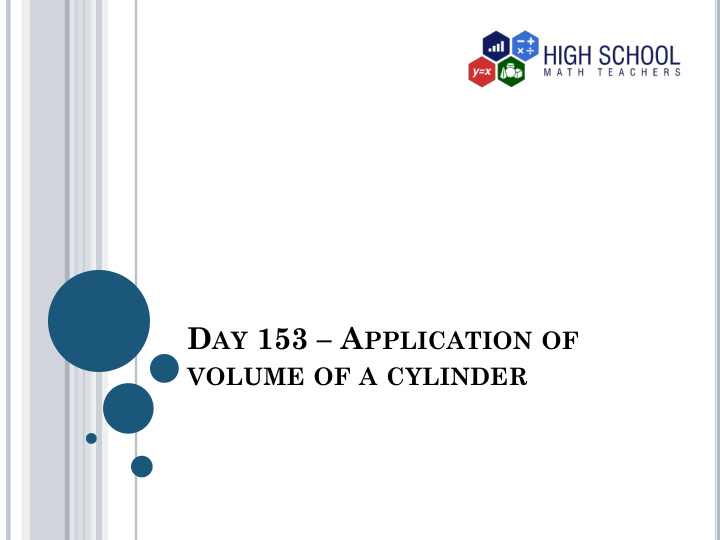



D AY 153 – A PPLICATION OF VOLUME OF A CYLINDER
I NTRODUCTION Cylindrical objects abound in real life. We have always come across cylindrical oil tankers, cylindrical water tanks, horse pipes and some tree trunks. The volume of an oil tanker depended on its radius and length. In this lesson, we will discuss the application of volume of a cylinder.
V OCABULARY Capacity This is the maximum volume that can be hold in a container.
Consider the cylinder below with a radius 𝑠 and a length 𝑚 . 𝑚 𝑠 The volume of a cylinder with radius 𝑠 and length 𝑚 is given by 𝑊 = 𝜌𝑠 2 × 𝑚. The applications of the volume of a cylinder are very many. We will discuss some of these applications.
1. Designing cylindrical water tanks Most water tanks are designed in a cylindrical shape. When designing tanks with a specific volume, one must ensure that its radius and the height gives the required volume. For instance, if one wants to have a tank with a volume of 210 cubic feet and space available to place the tank is a square room measuring 6 𝑔𝑢 𝑐𝑧 6 𝑔𝑢, he/she will be required to have a tank with a diameter of 6 𝑔𝑢 . We may calculate the height of the tank as follows. 𝑊 𝑊 = 𝜌𝑠 2 𝑚 ⟹ 𝑚 = 𝜌𝑠 2 210 𝑚 = 3.142×3 2 = 7.426 𝑔𝑢
2. Oil tankers Most oil tankers are cylindrical in shape to increase the roll stability. The volume of these tankers is dependent on their length and radius. Example 1 Oil tanker has a length of 30 𝑔𝑢 and a radius of 4 𝑔𝑢. Find volume of oil contained in the tanker when full in cubic feet. Solution The volume of the oil contained inside is equal to the volume of the whole tanker. Volume of tanker = 𝜌𝑠 2 × 𝑚 = 3.142 × 4 2 × 30 = 1508.16 𝑔𝑢 3
3. Manufacture of liquid containers Most liquid containers are cylindrical in shape. Their radius and height determines their capacity. Example 3 A water container has a diameter of 0.8 𝑔𝑢 and a height of 1.8 𝑔𝑢 . How many gallons of water does it contain when it is full? ( 1 𝑔𝑢 3 = 7.5 𝑏𝑚 ) Solution Diameter is 0.8 𝑔𝑢 . So the radius is 0.4 𝑔𝑢. Volume = 3.142 × 0.4 2 × 1.8 = 0.905 𝑔𝑢 3 0.905 × 7.5 = 6.7 gallons.
4. Finding the volume of irregular objects . Irregular objects such as a stone do not have uniform measurements which can help us to find their volume. We find the volume of an irregular object by dipping it in water contained in a cylindrical jar worse radius is known. The change of height of the water is noted, and then the volume calculated. This is only applicable to an irregular object that sinks.
HOMEWORK A cylindrical container of radius 0.5 𝑔𝑢 and height 2 𝑔𝑢, is filled with diesel using a jar of diameter 8 𝑗𝑜 and a height of 9 𝑗𝑜. How many jarfuls will fill the container.
A NSWERS TO HOMEWORK 6 jarfuls
THE END
Recommend
More recommend